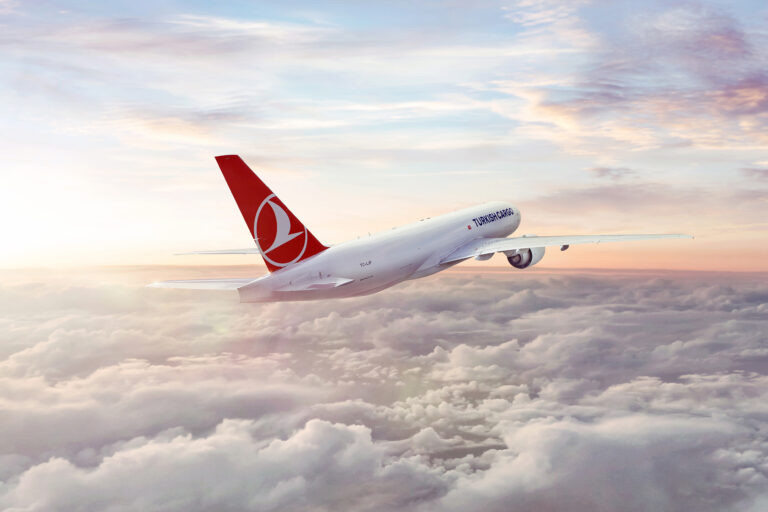From pandemic pivots to sustained profitability, Turkish Cargo has emerged as one of the most assertive players in global air freight. But the goal is now more ambitious: become one of the top three cargo carriers by volume by 2028 and lead the global air cargo industry by 2033, not only in scale but in service specialisation and resilience. That trajectory is already ahead of schedule.
“In 2024, Turkish Cargo became the world’s third-largest air cargo carrier, four years ahead of our original target,” said Ali Türk, Chief Cargo Officer at Turkish Airlines. “This achievement reflects our unwavering focus on long-term strategy, operational excellence, and future-focused investment.”
Turkish Cargo’s operational blueprint rests on building the right kind of scale. Not expansion for its own sake, but aligned with targeted markets, customer demand, and service complexity. The current fleet of 26 freighters is already expanding with orders for four Boeing 777Fs and ten Airbus A350Fs.
“Our goal is to reach 44 freighters by 2033,” Türk confirmed. These aircraft were selected not just for their payload capacity, but for their strategic fit. “New-generation aircraft provide increased fuel efficiency, extended range, and higher payload capacity. This enables us to expand services on strategic long-haul routes.”
Turkish Airlines’ broader fleet expansion—set to exceed 800 aircraft by 2033—reinforces this freight ambition. With one of the most geographically connected networks in aviation, the cargo division leverages the belly capacity of a vast passenger fleet to extend reach and frequency in emerging and underserved markets.
150 cargo destinations and counting
Türk pointed to the expansion of Turkish Cargo’s destination network from 111 to 150 as a cornerstone of its global growth. “We evaluate destinations based on trade potential, operational feasibility, and customer demand,” he said.
This strategy is enabled by SMARTIST, the carrier’s high-capacity cargo hub in Istanbul, and further reinforced by its growing automation, which increases the speed and accuracy of turnaround times. But beyond infrastructure, the expansion is calibrated against shifting global trade flows and geopolitical realities.
“During the pandemic, we operated more than 7,000 cargo-only flights and built a global medical corridor connecting over 400 destinations,” Türk recalled. “This flexibility continues today through scenario-based planning, dynamic capacity management, and strong execution on the ground.”
Special cargo takes centre stage
Turkish Cargo is not just growing—it is evolving. By 2033, the carrier expects 55 percent of its revenue to come from special cargo and e-commerce. This pivot reflects a fundamental shift in the air cargo value chain, where speed, temperature control, and handling precision now define premium service.
“We are reshaping our portfolio to reflect the future of air cargo,” said Türk. “By 2033, we expect e-commerce and special cargo—including pharma, live animals, perishables, and valuables—to account for over 55 percent of our revenues.”
The company’s investment in vertical products reflects this change. TK Pharma, TK Fresh, and TK Live are not just marketing labels—they are supported by dedicated infrastructure, certified processes, and trained specialists.
“Within our projected SMARTIST capacity of 4.5 million tons, 2 million tons will be allocated for special cargo,” he added. That means thermal mapping, real-time monitoring, AI-powered anomaly detection, and increased automation in cold chain handling.
TK Pharma, in particular, is positioned for growth. The service is structured around three tiers: Standard (dedicated handling and storage), Extra (24/7 monitoring and tarmac dollies), and Advanced (active container solutions from –70°C to +30°C). These are not just operational differentiators, but compliance tools.
“We hold CEIV Pharma and GDP certifications,” said Türk. “We operate a dedicated Temperature Controlled Center (TCC) at SMARTIST, built to meet international standards.” With the expansion of SMARTIST 2.0, cold chain capacity will be doubled—further strengthening Turkish Cargo’s position in healthcare logistics.
Digital tools for performance and
predictability
Cargo growth at this scale demands control, and for Turkish Cargo, digitalisation plays a central role in ensuring precision, not just volume. Technologies such as real-time cargo tracking, intelligent scanning, and AI-supported load planning allow the carrier to deliver “smarter, faster, and more secure logistics solutions,” according to Türk.
For sensitive cargo, IoT sensors track temperature, humidity, and location in real time. Internally, digital platforms like CAPRON and ULD contour reporting are used to synchronise apron movements and boost ramp-side efficiency.
Blockchain is under review, but Türk’s approach is grounded: “We prioritise technologies that offer practical value, scalability, and transparency.”
In a sector shaped by volatility, Türk sees adaptability as a strategic asset. “In today’s volatile logistics landscape, resilience is a competitive advantage,” he said. Whether responding to economic shocks, regulatory changes, or disruptions in global supply chains, the company’s planning is designed to be flexible.
That includes scenario modelling, responsive network planning, and a decentralised decision-making structure that enables rapid adjustments. “We combine strategic foresight with operational agility to remain adaptable, reliable, and focused on sustainable growth,” Türk said.
The road to 2033
Turkish Cargo’s goal to lead the global air cargo industry by 2033 is audacious, but not without a foundation. The company has already surpassed key milestones ahead of schedule and is now deepening its commitment to high-yield services, digital transparency, and fleet modernisation.
But the real story is not about size. It is about shaping an air cargo business that is responsive to complexity, capable of absorbing shocks, and built to meet a new generation of supply chain demands.
As Türk put it, “We aim to lead not only in size but also in agility, innovation, and reliability.”
The challenge over the next decade will be maintaining that balance—and proving that cargo growth, when strategically executed, is not just about more tonnes moved, but more value delivered.



